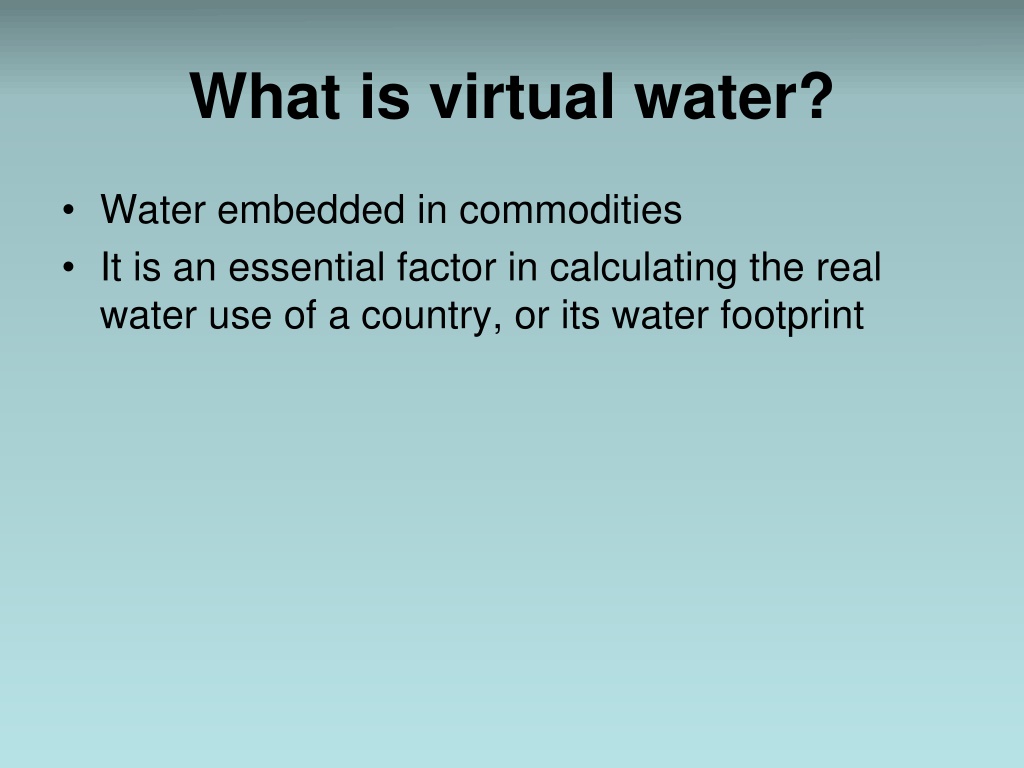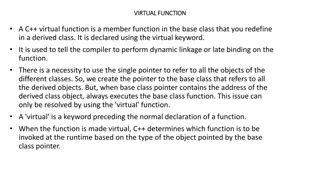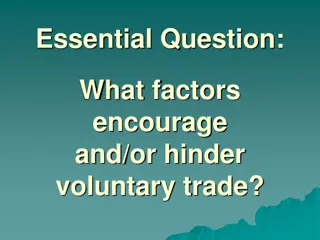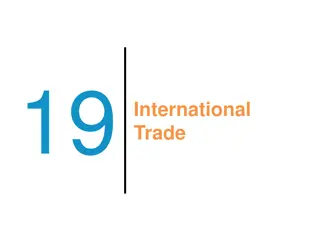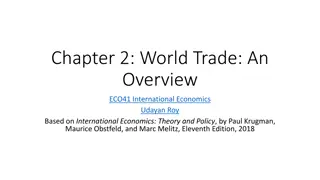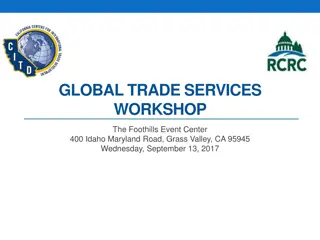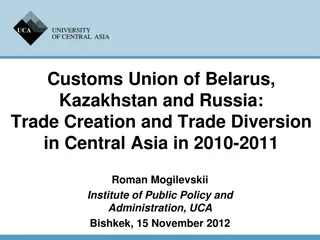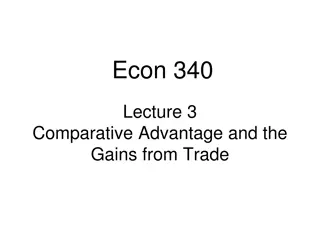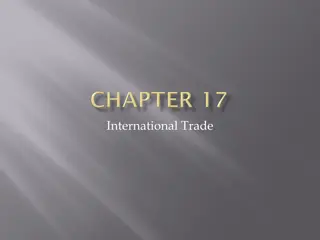Understanding Virtual Water: Key Factors and Global Trade Patterns
Virtual water refers to the water embedded in commodities, playing a crucial role in calculating a country's water footprint. This concept aids in understanding real water usage, trade patterns, and dependencies among nations. The global virtual water trade, with significant importers like Sri Lanka and Japan and exporters such as the USA and Canada, reflects the interconnectedness of water resources on a global scale. Explore the implications, top products, and regions influencing virtual water trade.
Download Presentation

Please find below an Image/Link to download the presentation.
The content on the website is provided AS IS for your information and personal use only. It may not be sold, licensed, or shared on other websites without obtaining consent from the author. Download presentation by click this link. If you encounter any issues during the download, it is possible that the publisher has removed the file from their server.
E N D
Presentation Transcript
What is virtual water? Water embedded in commodities It is an essential factor in calculating the real water use of a country, or its water footprint
How Important Is It? Average U.S. Water Use (gallons) 100 270 1056 700 Food Energy Products Home
Virtual Water Trade Global virtual water trade 67% crops 33% livestock products 10% industrial products The regions with a significant net virtual water import are: - Central and South Asia - Western Europe, North Africa - Middle East
Top 5 virtual importing countries (1995-1999) COUNTRY NET IMPORT VOLUME (109m3) Sri Lanka 428.5 Japan 297.4 Netherlands 147.7 Korea Rep. 112.6 China 101.9 What is meant by net volume?
Gross Virtual Water Import and Export by Region For the period of 1995-1999
Virtual Water Imports - Exports Which regions are more dependent on other regions?
Top 3 virtual exporting countries (1995-1999) COUNTRY NET EXPORT VOLUME (109 m3) USA 758.3 Canada 272.5 Thailand 233.3 What are the ramifications of being an exporter of virtual water?
From Whom to Where? https://arch3230roshnimahtani.wordpress.com/2012/09/
Global virtual water trade between nations: top 10 crop products (1995-1999) PRODUCT % OF THE VIRTUAL WATER TRADE 30.20 17.07 15.36 8.85 7.20 4.88 2.71 2.01 1.97 wheat soybean rice maize raw sugar barley sunflower sorghum bananas Source: A.Y. Hoekstra; P.Q. Hung. Virtual water trade - A quantification of virtual water flows between nations in relation to international crop trade.
Water requirement equivalent of main food products PRODUCT UNIT WATER (m3 per unit) cattle sheep and goats fresh beef fresh poultry cereals citrus fruits palm oil roots and rubber head 4,000 head 500 kg 15 kg 6 kg 1.5 kg 1 kg 2 kg 1 Source: FAO, 1997. Published in the UN World Water Development Report.
Put these Values in Context It takes ~2,500 liters to fill an Olympic- sized swimming pool. How can it take so much water to produce these items? Where do you think it goes?
Water Use vs. Virtual Water Flow Virtual Water Flow Virtual Water Flow Virtual Water Flow Waste Water Food Processer Farmer Retailer Consumer 15,340 liters CROP WATER 1300 kg GRAIN + 7200 kg ROUGHAGES + 24,000 l DRINKING + 7,000 l SERVICING 1 COW 200 kg BEEF 2400 liters in one burger
Put these Values in Context Virtual Water Calculation Exercise Estimate the number of cotton t-shirts you own. Multiply by the virtual water content (2000 l/shirt) How many liters of virtual water? Estimate the number of leather shoes you own. Multiply by the virtual water content (8000 l/pair) How many liters water? Add the virtual H20 content from both items together. Divide by 2,500 liters/Olympic-sized swimming pool. How many Olympic-sized swimming pools does this equal?
Put these Values in Context What is the minimum quantity of water needed for a person per day? The World Health Organization says about 20 liters per capita per day should be assured to take care of basic hygiene needs and basic food hygiene, as well as for drinking. How many people could the virtual water of your shirts and shoes support for one day?
Amount of Virtual Water per Food per Country in m3/ton World Avg 3419 1334 909 15497 3918 U.S. China India Russia Australia Brazil Italy Rice Wheat Corn Beef Chicken 1903 849 489 13193 12560 2389 1972 690 801 4254 1654 1937 16482 7736 3584 2375 1397 21028 5763 1525 1588 744 17112 2914 4600 1616 1180 16961 3913 2506 2421 530 21167 2198 3652 Why the big difference in how much water it takes to produce the same food items in different countries?
Amount of Virtual Water per Food per Country in m3/ton World Avg 3419 1334 909 15497 3918 U.S. China India Russia Australia Brazil Italy Rice Wheat Corn Beef Chicken 1903 849 489 13193 12560 2389 1972 690 801 4254 1654 1937 16482 7736 3584 2375 1397 21028 5763 1525 1588 744 17112 2914 4600 1616 1180 16961 3913 2506 2421 530 21167 2198 3652 The big difference between the countries is due to the climate, applied technology, and the amount of production related to it.
Virtual Water Needed to Maintain a Daily Diet (L/Day) Sub-Saharan Africa South & East Asia China Latin America Middle East/N-Africa Oceania/Pacific Russia Western Europe North America 0 1000 2000 3000 4000 5000 6000 After Schrier, H (2004). Virtual Water Calculation, in Virtual Water and Global Food Security: Implications for Canada. Univ. of British Columbia. http://ubclfs- wmc.landfood.ubc.ca/webapp/VWM/course/food-export-virtual-water-3/virtual-water-calculation-9/
Water Requirements of Meat The American diet requires twice as much water as diets common in some Asian and European nations. ~40% of world s grain production went to livestock at the turn of the century. Over the past few decades, consumption of meat in developing countries has grown at a rate of about 5 to 6% per year; consumption of milk and dairy products at 3 to 4%. What are the ramifications of these statistics? How is this a water sustainability concern?
Virtual Water Case Study Water Stress in China There is a geographical mismatch between freshwater demand and available freshwater. The North China Plain shows the greatest water scarcity, with per capita water availability < 150 m3/y China has been developing: >20 major physical water transfer projects, with a total length >7,200 km, including the world s largest the South North Water Transfer Project (SNWTP)
Virtual Water Case Study Water Stress in China
Virtual Water Transfer Within China Much greater amounts than the physical transfers Keep these maps in mind when we look at water footprints Gm3 = giga cubic meter = 1 billion cubic meters
Virtual Water Debate Preparation Get in groups of 4 Prepare to make a case both in support and against the following statement: More of the world should rely on virtual water trade Come up with arguments for and against (10 min) Discuss the ramifications of these positions (5 min) Find out where your group members stand on this issue (5 min)
Virtual Water Debate Preparation At the beginning of the next class, students on one side of the classroom will argue for the affirmative side of the statement students on the other side of the room will argue the negative side. Only then will you learn which side of the debate you are on.
